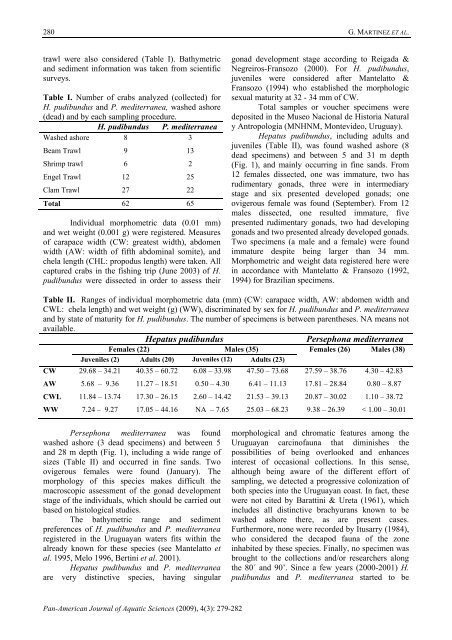Download full issue - PanamJAS
Download full issue - PanamJAS
Download full issue - PanamJAS
You also want an ePaper? Increase the reach of your titles
YUMPU automatically turns print PDFs into web optimized ePapers that Google loves.
280<br />
G. MARTINEZ ET AL.<br />
trawl were also considered (Table I). Bathymetric<br />
and sediment information was taken from scientific<br />
surveys.<br />
Table I. Number of crabs analyzed (collected) for<br />
H. pudibundus and P. mediterranea, washed ashore<br />
(dead) and by each sampling procedure.<br />
H. pudibundus P. mediterranea<br />
Washed ashore 8 3<br />
Beam Trawl 9 13<br />
Shrimp trawl 6 2<br />
Engel Trawl 12 25<br />
Clam Trawl 27 22<br />
Total 62 65<br />
Individual morphometric data (0.01 mm)<br />
and wet weight (0.001 g) were registered. Measures<br />
of carapace width (CW: greatest width), abdomen<br />
width (AW: width of fifth abdominal somite), and<br />
chela length (CHL: propodus length) were taken. All<br />
captured crabs in the fishing trip (June 2003) of H.<br />
pudibundus were dissected in order to assess their<br />
gonad development stage according to Reigada &<br />
Negreiros-Fransozo (2000). For H. pudibundus,<br />
juveniles were considered after Mantelatto &<br />
Fransozo (1994) who established the morphologic<br />
sexual maturity at 32 - 34 mm of CW.<br />
Total samples or voucher specimens were<br />
deposited in the Museo Nacional de Historia Natural<br />
y Antropología (MNHNM, Montevideo, Uruguay).<br />
Hepatus pudibundus, including adults and<br />
juveniles (Table II), was found washed ashore (8<br />
dead specimens) and between 5 and 31 m depth<br />
(Fig. 1), and mainly occurring in fine sands. From<br />
12 females dissected, one was immature, two has<br />
rudimentary gonads, three were in intermediary<br />
stage and six presented developed gonads; one<br />
ovigerous female was found (September). From 12<br />
males dissected, one resulted immature, five<br />
presented rudimentary gonads, two had developing<br />
gonads and two presented already developed gonads.<br />
Two specimens (a male and a female) were found<br />
immature despite being larger than 34 mm.<br />
Morphometric and weight data registered here were<br />
in accordance with Mantelatto & Fransozo (1992,<br />
1994) for Brazilian specimens.<br />
Table II. Ranges of individual morphometric data (mm) (CW: carapace width, AW: abdomen width and<br />
CWL: chela length) and wet weight (g) (WW), discriminated by sex for H. pudibundus and P. mediterranea<br />
and by state of maturity for H. pudibundus. The number of specimens is between parentheses. NA means not<br />
available.<br />
Hepatus pudibundus<br />
Persephona mediterranea<br />
Females (22) Males (35) Females (26) Males (38)<br />
Juveniles (2) Adults (20) Juveniles (12) Adults (23)<br />
CW 29.68 – 34.21 40.35 – 60.72 6.08 – 33.98 47.50 – 73.68 27.59 – 38.76 4.30 – 42.83<br />
AW 5.68 – 9.36 11.27 – 18.51 0.50 – 4.30 6.41 – 11.13 17.81 – 28.84 0.80 – 8.87<br />
CWL 11.84 – 13.74 17.30 – 26.15 2.60 – 14.42 21.53 – 39.13 20.87 – 30.02 1.10 – 38.72<br />
WW 7.24 – 9.27 17.05 – 44.16 NA – 7.65 25.03 – 68.23 9.38 – 26.39 < 1.00 – 30.01<br />
Persephona mediterranea was found<br />
washed ashore (3 dead specimens) and between 5<br />
and 28 m depth (Fig. 1), including a wide range of<br />
sizes (Table II) and occurred in fine sands. Two<br />
ovigerous females were found (January). The<br />
morphology of this species makes difficult the<br />
macroscopic assessment of the gonad development<br />
stage of the individuals, which should be carried out<br />
based on histological studies.<br />
The bathymetric range and sediment<br />
preferences of H. pudibundus and P. mediterranea<br />
registered in the Uruguayan waters fits within the<br />
already known for these species (see Mantelatto et<br />
al. 1995, Melo 1996, Bertini et al. 2001).<br />
Hepatus pudibundus and P. mediterranea<br />
are very distinctive species, having singular<br />
morphological and chromatic features among the<br />
Uruguayan carcinofauna that diminishes the<br />
possibilities of being overlooked and enhances<br />
interest of occasional collections. In this sense,<br />
although being aware of the different effort of<br />
sampling, we detected a progressive colonization of<br />
both species into the Uruguayan coast. In fact, these<br />
were not cited by Barattini & Ureta (1961), which<br />
includes all distinctive brachyurans known to be<br />
washed ashore there, as are present cases.<br />
Furthermore, none were recorded by Itusarry (1984),<br />
who considered the decapod fauna of the zone<br />
inhabited by these species. Finally, no specimen was<br />
brought to the collections and/or researchers along<br />
the 80´ and 90’. Since a few years (2000-2001) H.<br />
pudibundus and P. mediterranea started to be<br />
Pan-American Journal of Aquatic Sciences (2009), 4(3): 279-282
















